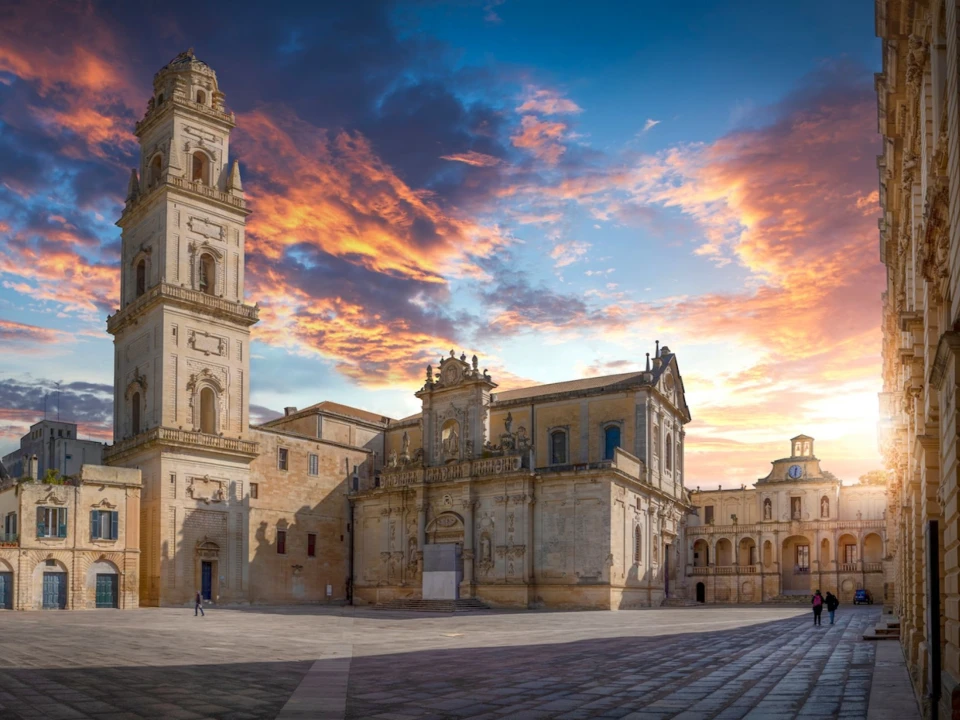Capital of the homonymous province and the cultural fulcrum of Salento (Apulia), Lecce is one of the most beautiful art cities in southern Italy. Known as the “Florence of the South,” Lecce knows how to astonish and intrigue visitors and locals alike.
Its ancient Messapian origins and its archaeological ruins, left behind after Roman domination, fuse with the richness and exuberance of the Baroque churches and palazzi (typically from the 1600s). Architectonic development and rich facade decoration were particularly fecund during the reign of the Kingdom of Naples, and they characterized this Apulian capital in such a unique way as to give birth to the term “Leccese Baroque.” It is a completely original style, also due to its use of Lecce stone, a type of chalky material – usually in warm colors – that is malleable and pliant.
The streets of the center of Lecce make up part of a museum under the open sky, and one of this museum’s most remarkable exhibits is its splendid Piazza del Duomo, site of the city’s Duomo, Cathedral of Maria Santissima Assunta. The Cathedral features a lovely bell tower and two façades, one rather sober in tone and the other highly-embellished. Other grand symbols of Lecce include Palazzo Vescovile, a Renaissance construction with a beautiful and evocative series of loggias; and Palazzo del Seminario, oft-noted for its ashlar (or hewed, squared stone) decorations and its characteristic cloister.
Not far away lies Piazza Sant’Oronzo, a treasure chest in itself of artistic and historic gems, all from different eras. Palazzo del Seggio (also known as the Sedile) dominates the piazza with its Renaissance elegance; today it hosts a number of enlightening and interesting exhibits and expositions. The Church of Santa Maria delle Grazie is in the same architectural style, while the majestic Amphitheatre in elliptical form, naturally, is evidence of Rome’s rule here - as is the Roman column, standing next to the bronze of the city’s Patron Saint, St. Orontius.
In Lecce’s surrounding neighborhoods we find the Church of San Giuseppe, with its Baroque façade, and the Castle of Charles V (Castello Carlo V), a fortified bastion built in the 1500s on the request of Emperor Charles V. The Castle comprises a central structure that was erected much before, in the 12th Century, while other of its elements were completed in the following era (for instance, the ditch). Once used as a defense, the Castle today welcomes visitors to its numerous art exhibits and cultural initiatives.
Another landmark that makes grand impact on the eye is the Porta Rudiae, surmounted by yet another statue of the Patron Saint, this time accompanied by San Domenico and St. Irene. Then, the beautiful façade of the Church of the Rosary seems to reach – in sweeping vertical movements – to the sky. A must-visit is the Basilica di Santa Croce (begun 14th Century), whose high points are its harmonious balance between the Classical and Baroque styles, and the magnificent beauty of its interior. The Basilica was begun in the 14th Century, and completed sometime in the 16th or 17th Century. Then, the monument to Fascism, a work that was headed by Francesco Antonio Zimbalo and Cesare Penna, abounds with Christian symbols and is topped with a large rosette.
Of course, a tour of Lecce would be incomplete without seeing its art galleries and museums. Among them all, the Provincial Archaeological Museum of San Castromediano is one of the brightest highlights for its extremely old artifacts from the Roman and Messapian Civilizations. Not to be left out are the Lecce Historic Museum (also a contemporary art gallery); the Franciscan Art Gallery inside Palazzo Fulgenzio; and the Museum of the Roman Theatre that, besides containing finds from local archaeological excavations, holds a collection of nine theatrical masks from Hadrian’s Villa in Tivoli.
As in many cities of southern Italy, Lecce is teeming with countless evening engagements for those who want to enjoy the arts and be entertained: from music to theatre, the city of Leccese Baroque is animated by lively social life and a vivacious student population, here to attend the homonymous University.




